Book contents
- Frontmatter
- Contents
- List of Contributors
- Preface
- PART I GENERAL PRINCIPLES
- PART II CLINICAL MANAGEMENT
- PART III ORGAN SITE OR SYSTEM-SPECIFIC MANIFESTATIONS
- 16 Cutaneous Manifestations of Chronic Graft versus Host Disease
- 17 Oral Chronic Graft versus Host Disease
- 18 Chronic Ocular Graft versus Host Disease
- 19 Gynecological Manifestations of Chronic Graft versus Host Disease
- 20 Gastrointestinal and Hepatic Manifestations of Chronic Graft versus Host Disease
- 21 Chronic Graft versus Host Disease and the Lung
- 22 Hematologic Complications of Chronic Graft versus Host Disease
- 23 Neurological Manifestations of Chronic Graft versus Host Disease
- 24 Rehabilitation Evaluation and Treatment of Patients with Chronic Graft versus Host Disease
- 25 Infections
- 26 Endocrine and Metabolic Effects of Chronic Graft versus Host Disease
- 27 Other Manifestations of Chronic Graft versus Host Disease
- 28 Psychosocial Issues in Chronic Graft versus Host Disease
- 29 Secondary Malignancies and Other Late Effects
- 30 Health-Related Quality of Life (HRQOL) in Chronic Graft versus Host Disease
- PART IV SPECIAL CONSIDERATIONS IN CHRONIC GVHD
- Index
- Plate section
16 - Cutaneous Manifestations of Chronic Graft versus Host Disease
from PART III - ORGAN SITE OR SYSTEM-SPECIFIC MANIFESTATIONS
Published online by Cambridge University Press: 26 August 2009
- Frontmatter
- Contents
- List of Contributors
- Preface
- PART I GENERAL PRINCIPLES
- PART II CLINICAL MANAGEMENT
- PART III ORGAN SITE OR SYSTEM-SPECIFIC MANIFESTATIONS
- 16 Cutaneous Manifestations of Chronic Graft versus Host Disease
- 17 Oral Chronic Graft versus Host Disease
- 18 Chronic Ocular Graft versus Host Disease
- 19 Gynecological Manifestations of Chronic Graft versus Host Disease
- 20 Gastrointestinal and Hepatic Manifestations of Chronic Graft versus Host Disease
- 21 Chronic Graft versus Host Disease and the Lung
- 22 Hematologic Complications of Chronic Graft versus Host Disease
- 23 Neurological Manifestations of Chronic Graft versus Host Disease
- 24 Rehabilitation Evaluation and Treatment of Patients with Chronic Graft versus Host Disease
- 25 Infections
- 26 Endocrine and Metabolic Effects of Chronic Graft versus Host Disease
- 27 Other Manifestations of Chronic Graft versus Host Disease
- 28 Psychosocial Issues in Chronic Graft versus Host Disease
- 29 Secondary Malignancies and Other Late Effects
- 30 Health-Related Quality of Life (HRQOL) in Chronic Graft versus Host Disease
- PART IV SPECIAL CONSIDERATIONS IN CHRONIC GVHD
- Index
- Plate section
Summary
INCIDENCE
Although advances in conditioning regimens, cell delivery, and graft versus host disease (GVHD) prophylaxis have improved the prognosis of patients following allogeneic stem cell transplantation (SCT), chronic GVHD (cGVHD) of the skin continues to be a significant source of long-term patient morbidity in SCT recipients. The skin is the most common target of cGVHD and is remarkably variable in its presentations, resulting in potential cosmetic, functional, and even life-threatening sequelae.
PRESENTATION
Cutaneous cGVHD may overlap with acute disease, occur de novo, or develop after a disease-free interval following acute GVHD. Traditionally, the onset of cGVHD was classified as greater than 100 days after hematopoietic stem cell transplantation (HSCT) and heralded by the appearance of lichen planus-like lesions or sclerodermoid (sclerodermalike) changes. Newer HSCT regimens, as well as the delivery of donor lymphocyte infusions, have altered the timing of this “classic” presentation. Accurate estimation of the true incidence of cutaneous cGVHD is further hindered by the diversity of its clinical presentation (Table 16.1).
An effort to create a systematic classification of the cutaneous manifestations of cGVHD were undertaken as part of the 2005 National Institute of Health (NIH) Consensus Development Project. The proposed criteria for the diagnosis of cutaneous cGVHD include (1) distinction from acute GVHD; (2) at least one diagnostic clinical sign of cGVHD or one distinctive manifestation confirmed by biopsy or relevant testing; (3) exclusion of other possible diagnoses.
- Type
- Chapter
- Information
- Chronic Graft Versus Host DiseaseInterdisciplinary Management, pp. 169 - 181Publisher: Cambridge University PressPrint publication year: 2009
- 2
- Cited by



